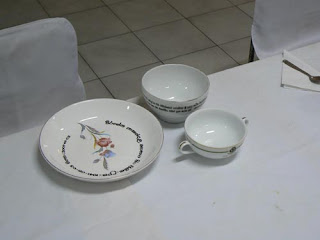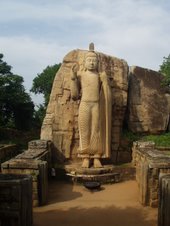

The dane ceremony basically amounted to the principle monk (the fellow third from the left) giving bane (i.e. preaching). In this instance he talked - amongst other things - about the importance of marriage and blessed both of us! The monks at the Dalida Maligawa are a funny breed of monk in that they are generally quite learned and pious - in this sense they are usually quite a bit more serious looking than other monks (and this saying a lot since the main purpose of being a monk is to precisely to be serious). After the monk fishes preaching, the pilgrims go about giving out the food that had been prepared the night before. This involved us going around and spooning food into the monks bowls. In this instance, the monks seemed quite pious since few of them would take any kind of meat.
Some of the food we provided:

An example of the monks bowls and cutlery - notice that they are all quite plain (again part of the ascetic ideal), except for the writing (which simply states who the donor of the cutlery was therefore guarenteing that they get the appropriate merit - and social recognition. Many material gifts for monks have the name of the donor written on them. It is part of the technological mechanics of merit aquisition). Also note that the chairs upon which the monks sit is quite low (i.e. the legs are short): this is all part of the complicated monastic code which is designed to help the monks reduce desires.

Here is the Buddha statue in the monks eating quarters. This statue also receives alms prior to the dane. One interesting innovation which might represent a modern Hinduistic influence is the use of bright strobe lights behind Buddha statues. They usually represent the lights emitted from the Buddha when he attained enlightenment (although the colours are hardly comprehensive). I say it might be a Hindu influence only because such opulance is quite un-Buddhist like. But Sri Lankans are very competitive and would hate the idea that a Hindu deity lhas more bling than their own Buddha statues!

Going to all the trouble of visiting the hill country, seeing the golden tooth, preparing a veritable banquet of food and attending to the monks at the Dalida Maligawa all involves a huge amount of merit aquisition. Many families - including Kumudu's - do this once a year so that the merit they reap will guarentee a good future (although any belief that they will benefit before they die would be misplaced, and I happen to think that people believe this rather un-Buddhistic notion). One other thing about the tooth relic: although it is enclosed in the ritual casket described above, the tooth itself has gone on display at various times. Reputably, it is extremely large and looks rather like a yak tooth - but one shouldn't let that get in the way of a good mythological ideal!
*Although it is called Kandy, the proper Singhalese name is Nuwara. "Nuwara" simply means 'Town', so in a way it implies simply 'the town'. This probably is a throwback to when Kandy was the capital of the high country, prior to when the English captured it. That is, it really was the only big town that locals could go to hence it being simply called 'the town'. The name 'Kandy' is an English invention based upon the Singhala for hill 'kandha'. Nuwara was too complicated to say, and saying kandha with its unstressed '-dha' sound was also too difficult, so Kandy was invented, i.e. to denote that the city is in the heart of the hill country.










 Overtaking (during - note bend):
Overtaking (during - note bend): 










 The pirith noola confers protection from bad luck (avasanava) which usually come in the form of devils (yaksha). However, the string only has power for three days, after which it can be cut off. In practice devout Buddhists often keep the string as long as possible - probably to demonstrate their piousness. I can say as a matter of experience that the string can get quite manky after a few days.
The pirith noola confers protection from bad luck (avasanava) which usually come in the form of devils (yaksha). However, the string only has power for three days, after which it can be cut off. In practice devout Buddhists often keep the string as long as possible - probably to demonstrate their piousness. I can say as a matter of experience that the string can get quite manky after a few days. 


